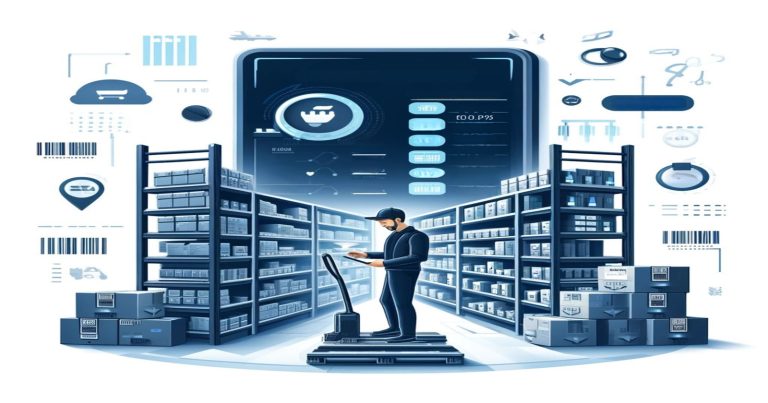An inventory management system is a software tool that helps a business manage, track, and control its stock. It allows real-time monitoring of products across sales, purchase, and storage. The system improves stock handling and cuts down human errors. Businesses use it to manage stock levels, avoid shortages, and meet customer demand. It plays a significant role in both retail and wholesale operations. The inventory management system supports faster order processing, accurate records, and better warehouse organization. A sound system also supports inventory tracking, alerts for low stock, and reports for future planning.
What is an Inventory Management System?
An inventory management system is a digital platform that allows businesses to handle their stock organizationally. It helps track goods from purchase to sale. The system updates records in real time and connects with other business tools. Companies in retail, manufacturing, and e-commerce use this system every day. Without a strong inventory system, a business cannot meet customer needs or manage supply chain processes smoothly.
Inventory Control and Stock Tracking
Businesses use the system to manage inventory control. It tracks each item’s location and movement inside the warehouse or shop. With proper tracking, business owners can reduce overstock and stockouts. When the system detects low stock, it raises alerts. Teams can then reorder items before the stock runs out.
Inventory tracking becomes easier when the system uses barcodes and scanners. These tools speed up product check-ins and check-outs. This also improves billing accuracy and product scanning during audits. Businesses use inventory tracking software to manage stock at multiple places without confusion.
Warehouse Inventory Management in Business
Warehouses need better control due to the large stock volume. The warehouse inventory management system tracks pallets, shelves, and individual product units. It also shows available space in the warehouse. Managers can better plan space usage. They can also reduce product damage, mix-up, and delay in order picking.
A strong warehouse management software gives clear reports. It shows where the stock lies and how fast each item sells. This data helps in placing fast-moving goods near dispatch zones. Slow items can go to the back of the warehouse.
Inventory System Software for All Sizes
Large firms and small businesses both use the inventory system software. Many startups and shops choose simple tools, while big firms use complete automated inventory system setups. Small shops use basic barcode systems, while big factories need to track thousands of products in full. The small business inventory management software includes easy billing tools, stock alerts, and supplier tracking. It helps save time and improves service speed for small stores.
Benefits of Using an Inventory Management System
Using an inventory management system gives many benefits to all types of businesses. It saves time, reduces errors, and improves profits. Stock records stay clean and updated. The staff spends less time checking stock manually. Managers make better decisions because they see the correct stock data.
Accurate Stock Records and Less Human Error
An automated system updates stock levels after every sale or purchase. Workers do not need to count stock again and again. This saves time and avoids mistakes. Wrong counts can cause over-buying or understocking. The inventory monitoring system sends reports that help the team fix stock issues early.
Real-time inventory tracking shows stock position when someone adds or sells a product. This keeps stock data fresh all day. It also improves teamwork as all departments use the exact numbers.
Faster Order Fulfilment and Fewer Delays
A business can pick, pack, and ship faster using an inventory system. Orders move smoothly as the system matches items to customer requests. Finding products is reduced when the warehouse is organised using a digital system.
Inventory optimisation helps remove extra stock and replace it with high-selling items. This saves money and space. Businesses can also avoid losses from expired or old products.
The stock management software shows which products sell the most. Business owners can focus on buying these items and avoid stocking less popular ones. This increases sales and customer satisfaction.
Better Integration With Other Business Systems
A sound inventory system connects with sales, billing, POS, and supplier tools. A POS inventory system links sales at the counter directly with stock levels. So, when the cashier makes a sale, the system reduces the stock count instantly.
Businesses also use inventory software on their websites for e-commerce inventory management. When someone buys online, the stock changes in real time. This prevents overselling and improves order accuracy. Online sellers keep customers happy because the system helps them deliver fast and on time.
How to Choose the Best Inventory Software?
Choosing the right inventory software is very important. Businesses must pick a tool that fits their size, needs, and budget. A bad choice wastes time and confuses. Owners must consider features, user-friendliness, price, and support before buying.
Know Your Business Needs First
Every business has different stock handling needs. A small bakery needs simple tracking, while a factory may need bulk stock tracking and expiry alerts. Business owners must first list what they expect the system to do.
Some may need alerts for low stock. Others may want expiry tracking for medicines. Retail shops may wish for the system to link with billing machines and printers. Warehouses may want to do space planning and batch tracking.
Look for Easy Setup and Support
Businesses should choose a system that is easy to set up and use. Teams work better when they find the system simple. Systems that need too much training slow down work. Choose one with clear buttons, fast response, and good help guides.
Also, support from the vendor is critical. If there is any problem, the vendor must fix it quickly. Many Indian businesses look for vendors who speak local languages and give phone or WhatsApp support.
Think About Cloud or Offline Options
Some systems run online using cloud storage. Others run on a computer offline. Online systems allow teams to access stock data from mobile devices or other cities. Offline systems work even if the internet fails. Businesses must choose based on their area and work style.
Small businesses in rural areas prefer offline systems due to poor internet. City stores choose cloud systems for more speed and flexibility. Businesses with many shops or warehouses also prefer cloud systems to sync all locations.
Features to Look for in an Inventory Management System
Good inventory software must offer helpful tools for daily use. It must handle tracking, reporting, and automation. The more useful features it has, the better the control over stock.
Barcode and Batch Tracking
The barcode inventory system makes tracking faster. A barcode scanner reads the item, adds it to the system, and updates stock. Workers do not need to type details again and again.
Batch tracking is also proper. It tracks items made in the same lot or batch. This helps in case of product returns or defects. The seller can check which batch had the issue.
Alerts, Reports, and Analytics
Stock alerts are beneficial. The system sends alerts when the stock goes below the set level. The team can place orders quickly. This avoids stockouts and customer complaints.
Daily, weekly, or monthly reports help in checking stock movement. Owners can see what sold fast and what did not. This allows them to change pricing, offers, or suppliers.
Advanced tools give insights into trends and forecasts. Businesses can plan purchases for festive or high-demand seasons using this data.
Multi-location and Multi-user Access
Businesses with multiple warehouses or shops need inventory control software that supports various locations. It shows the total stock across all places. Staff at each location can access only their data if needed.
Multi-user access allows different teams to work at the same time. Billing, storekeeping, and sales teams can all update and check stock without waiting.
The supply chain management system benefits when inventory data stays correct and fresh. From supplier to customer, every step moves faster.
| Software | Best For | Key Features | Price (₹) | Mobile App |
| Zoho Inventory | Online Sellers, SMEs | Barcode, Multi-channel, Real-time tracking | From ₹2,500/month | Yes |
| Vyapar | Small Shops, Kirana Stores | Billing, GST, Stock Alerts | From ₹599/year | Yes |
| Marg ERP | Retail, Wholesale, Pharma | Expiry, Stock Control, Warehouse management | ₹9,000 (one-time) | Yes |
| TallyPrime | Accounting + Inventory Needs | Multi-location, Batch Tracking | From ₹18,000/year | Limited |
| Busy Software | Traders, Manufacturers | POS, Stock Tracking, GST Billing | From ₹9,000/year | Yes |
Relevance to ACCA Syllabus
Inventory management is key to ACCA’s financial accounting and management accounting papers. Candidates must understand inventory valuation methods (FIFO, LIFO, Weighted Average), cost measurement, and how Inventory affects financial statements under IAS 2 – Inventories. This knowledge is essential for accurate financial reporting and analysis.
Inventory Management System ACCA Questions
Q1: Under IAS 2, which of the following is not included in the cost of inventories?
A) Purchase price
B) Import duties and handling charges
C) Storage costs for finished goods
D) Direct labour
Answer: C) Storage costs for finished goods
Q2: Which inventory valuation method results in the highest net income in times of rising prices?
A) LIFO
B) FIFO
C) Weighted Average
D) Specific Identification
Answer: B) FIFO
Q3: Inventory should be measured at:
A) Historical cost
B) Net realisable value
C) Lower cost and net realisable value
D) Replacement cost
Answer: C) Lower cost and net realisable value
Q4: Which standard governs the accounting treatment for inventories?
A) IFRS 9
B) IAS 16
C) IAS 2
D) IFRS 15
Answer: C) IAS 2
Q5: A fall in the net realisable value of Inventory should be:
A) Ignored
B) Treated as a prior period error
C) Charged to revaluation reserve
D) Recognised as an expense in the period
Answer: D) Recognised as an expense in the period.
Relevance to US CMA Syllabus
The US CMA exam focuses heavily on cost and performance management. Inventory management is essential in budgeting, cost control, and profitability analysis. Topics such as inventory valuation, EOQ (Economic Order Quantity), and JIT (Just-in-Time) are core components in both Part 1 (Financial Planning, Performance and Analytics) and Part 2 (Strategic Financial Management).
Inventory Management System CMA Questions
Q1: What does EOQ primarily aim to minimize?
A) Sales returns
B) Total inventory cost
C) Selling expenses
D) Depreciation expense
Answer: B) Total inventory cost
Q2: In JIT inventory systems, what is the main objective?
A) Maximize bulk purchases
B) Minimize raw material quality
C) Eliminate Inventory holding costs
D) Maximize lead times
Answer: C) Eliminate Inventory holding costs
Q3: Which of the following is a carrying cost of Inventory?
A) Cost of placing an order
B) Insurance on Inventory
C) Transportation cost
D) Product returns
Answer: B) Insurance on Inventory
Q4: If a company overstates ending Inventory, the result is:
A) Overstated cost of goods sold
B) Understated gross profit
C) Overstated net income
D) No effect on profit
Answer: C) Overstated net income
Q5: Which costing method is typically used in a perpetual inventory system?
A) Standard cost
B) Specific identification
C) FIFO
D) LIFO
Answer: B) Specific identification
Relevance to CFA Syllabus
Inventory analysis is vital to the CFA Level I and II exams, mainly in Financial Reporting & Analysis (FRA). It helps candidates assess how inventory valuation affects profitability, liquidity, and ratios like inventory turnover, current ratio, and gross margin.
Inventory Management System CFA Questions
Q1: In periods of inflation, which method results in the lowest tax expense?
A) FIFO
B) Weighted Average
C) LIFO
D) Specific Identification
Answer: C) LIFO
Q2: Inventory turnover is calculated as:
A) Ending Inventory ÷ Cost of Goods Sold
B) Cost of Goods Sold ÷ Average Inventory
C) Average Inventory ÷ Net Sales
D) Net Sales ÷ Ending Inventory
Answer: B) Cost of Goods Sold ÷ Average Inventory
Q3: When comparing FIFO and LIFO, which better approximates current inventory value during inflation?
A) FIFO
B) LIFO
C) Weighted Average
D) Specific Identification
Answer: A) FIFO
Q4: If a company changes its inventory valuation method, it should:
A) Ignore the effect in financial statements
B) Adjust prospectively
C) Apply changes retrospectively
D) Report the change only in the audit note
Answer: C) Apply changes retrospectively
Q5: Which ratio is directly impacted by a change in inventory valuation method?
A) Return on Equity
B) Inventory Turnover
C) Interest Coverage
D) Quick Ratio
Answer: B) Inventory Turnover
Relevance to US CPA Syllabus
Inventory valuation is key in the US CPA exam’s FAR (Financial Accounting and Reporting) section. Candidates must know GAAP vs IFRS treatment of Inventory, LIFO reserve, and lower cost or market. It’s also tested in BEC and AUD for operational auditing and cost management.
Inventory Management System CPA Questions
Q1: Under US GAAP, the lower of cost or market rule is applied to Inventory using:
A) Replacement cost only
B) Historical cost only
C) Net realizable value only
D) Middle value of replacement cost, net realizable value, and floor
Answer: D) Middle value of replacement cost, net realizable value, and floor
Q2: The difference between Inventory under FIFO and LIFO is known as:
A) Gross margin spread
B) Inventory turnover
C) LIFO reserve
D) Inventory obsolescence
Answer: C) LIFO reserve
Q3: Under US GAAP, LIFO is allowed, but under IFRS:
A) LIFO is also allowed
B) LIFO is mandatory
C) LIFO is prohibited
D) LIFO is only allowed for manufacturers
Answer: C) LIFO is prohibited
Q4: Which costing method is most often used in periodic inventory systems?
A) Specific identification
B) Weighted average
C) LIFO perpetual
D) Retail inventory method
Answer: B) Weighted average
Q5: If ending Inventory is understated, what is the effect on the cost of goods sold and net income?
A) COGS overstated, Net Income understated
B) COGS understated, Net Income overstated
C) COGS and Net Income unchanged
D) COGS and Net Income are both overstated
Answer: A) COGS overstated, Net Income understated


